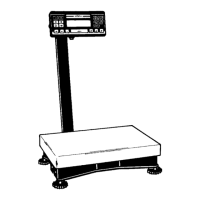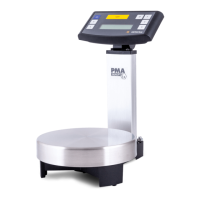Do you have a question about the Sartorius QC7CCE-D and is the answer not in the manual?
Detailed steps for mounting the display on the scale's short side.
Detailed steps for mounting the display on the scale's long side.
Instructions for setting up the display as a remote unit.
Guidance on removing and securing transport locking devices.
Explains the meaning and importance of verification marks.
Information on auxiliary devices approved for legal metrology use.
Safety considerations for installing the scale in safe areas.
Details the EU directive governing non-automatic weighing instruments.
How to power the scale on and off using the key.
Basic steps for performing a simple weight measurement.
Steps for connecting printers, PCs, or other peripherals.
Proper procedures for cleaning the scale safely.
How to access and modify scale settings via the operating menu.
Step-by-step guide for altering specific menu codes.
Procedures for external calibration and linearization of the scale.
Setting the data transmission speed for the interface.
Configuring the parity bit for error checking in data transmission.
Setting the number of stop bits for data transmission.
Configuring handshake protocols for data communication.
Defining how and when data is output from the scale.
Setting up automatic data output and controlling the function.
Using the scale for counting parts based on reference quantity or weight.
Storing tare values or performing tare calculations.
Summing up weighed values and piece counts.
Checking if samples fall within specific tolerance ranges.
Modifying the reference quantity for accurate counting.
Entering the weight of a single part for counting.
Lists and explains common operating errors and their codes.
Overview of essential keys and their functions on the scale.
Step-by-step instructions for basic weighing operations.
Steps for performing external scale adjustment and calibration.
Procedure for external linearization to improve accuracy.
Highlights key menu codes relevant to weighing parameters.
Detailed steps for mounting the display on the scale's short side.
Detailed steps for mounting the display on the scale's long side.
Instructions for setting up the display as a remote unit.
Guidance on removing and securing transport locking devices.
Explains the meaning and importance of verification marks.
Information on auxiliary devices approved for legal metrology use.
Safety considerations for installing the scale in safe areas.
Details the EU directive governing non-automatic weighing instruments.
How to power the scale on and off using the key.
Basic steps for performing a simple weight measurement.
Steps for connecting printers, PCs, or other peripherals.
Proper procedures for cleaning the scale safely.
How to access and modify scale settings via the operating menu.
Step-by-step guide for altering specific menu codes.
Procedures for external calibration and linearization of the scale.
Setting the data transmission speed for the interface.
Configuring the parity bit for error checking in data transmission.
Setting the number of stop bits for data transmission.
Configuring handshake protocols for data communication.
Defining how and when data is output from the scale.
Setting up automatic data output and controlling the function.
Using the scale for counting parts based on reference quantity or weight.
Storing tare values or performing tare calculations.
Summing up weighed values and piece counts.
Checking if samples fall within specific tolerance ranges.
Modifying the reference quantity for accurate counting.
Entering the weight of a single part for counting.
Lists and explains common operating errors and their codes.
Overview of essential keys and their functions on the scale.
Step-by-step instructions for basic weighing operations.
Steps for performing external scale adjustment and calibration.
Procedure for external linearization to improve accuracy.
Highlights key menu codes relevant to weighing parameters.
| Readability | 0.01 g |
|---|---|
| Linearity | ±0.02 g |
| Interface | RS-232 |
| Storage Temperature | -20°C to +60°C |
| Protection Class | IP54 |
| Repeatability | 0.01 g |
| Display | LCD |
| Maximum Capacity | 7200 g |











